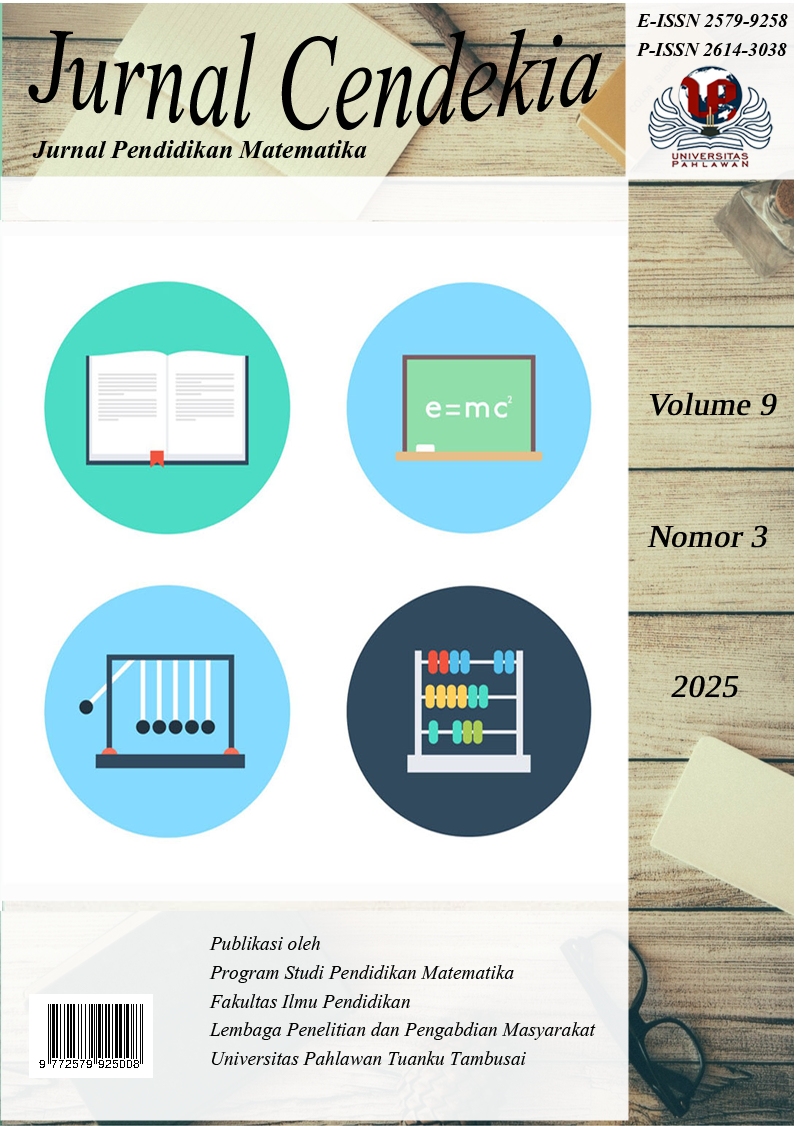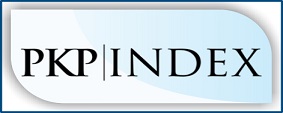Efektivitas Model Pembelajaran Kooperatif Think Pair Share Berbantuan Liveworksheet dan Zep Quiz untuk Meningkatkan Hasil Belajar Matematika Siswa
Abstract
Capaian belajar matematika siswa di Indonesia yang terpotret dalam laporan PISA 2022 serta hasil Asesmen Nasional 2021, menunjukkan perlunya inovasi pembelajaran yang dapat memperkuat pemahaman serta partisipasi aktif siswa. Tujuan penelitian ini adalah mengkaji efektivitas model TPS yang dipadukan dengan media interaktif Liveworksheet dan Zep Quiz pada materi trigonometri, khususnya relasi sudut. Pendekatan penelitian menggunakan metode kuantitatif dengan desain eksperimen semu tipe posttest-only control group design. Subjek penelitian mencakup siswa kelas X SMAN 2 Sidoarjo tahun ajaran 2024/2025. Kelas X-2 ditetapkan sebagai kelas yang diberi perlakuan, sedangkan kelas X-11 sebagai kelas yang tidak diberi perlakuan. Alat ukur yang dipakai berupa tes hasil belajar berisi soal pilihan ganda serta uraian. Data dianalisis menggunakan uji Mann-Whitney U karena tidak berdistribusi normal, disertai perhitungan ukuran efek menggunakan rank biserial correlation. Analisis menunjukkan perbedaan yang signifikan (p < 0,001) antara kelompok eksperimen dengan kelompok kontrol. Nilai rata-rata yang diperoleh kelompok eksperimen adalah 89,3, sementara kelompok kontrol memperoleh 69,9. Nilai effect size –0,937 tergolong sangat besar, sehingga dapat disimpulkan bahwa penerapan model TPS berbantuan Liveworksheet dan Zep Quiz mampu meningkatkan hasil belajar matematika siswa. Temuan ini menegaskan urgensi integrasi media digital interaktif dengan strategi kolaboratif sebagai sarana mewujudkan pembelajaran aktif, inovatif, dan sesuai dengan tuntutan abad ke-21.
Downloads
References
Alsina, Á., Pincheira, N., Barquero, B., Sellas, I., & Marimon-Martí, M. (2025). Responsive
mathematics teaching and mathematics teacher noticing: a systematic review in early childhood and primary education. Mathematics Education Research Journal, 0123456789. https://doi.org/10.1007/s13394-025-00519-2
Ay Emanet, E., & Kezer, F. (2021). The effects of student-centered teaching methods used in mathematics courses on mathematics achievement, attitude, and anxiety: a meta-analysis study. Participatory Educational Research, 8(2), 240–259. https://doi.org/10.17275/PER.21.38.8.2
Cevikbas, M., & Kaiser, G. (2022). Student Engagement in a Flipped Secondary Mathematics
Classroom. International Journal of Science and Mathematics Education, 20(7), 1455–1480. https://doi.org/10.1007/s10763-021-10213-x
Chang, L. Y.-H. (2022). An Exploration of Students’ Learning Motivation and Level of Participation through the Use of Mobile Tech in Classrooms. English Language Teaching, 16(1), 92. https://doi.org/10.5539/elt.v16n1p92
Chang, S. L., Wu, W. C., Hu, Y. J., Lai, H. Y., & Wong, T. C. (2022). Quasi-experimental design for using an interactive social media intervention program to improve truck drivers’ health beliefs and eating behaviors. BMC Public Health, 22(1), 1–13. https://doi.org/10.1186/s12889-022-13883-6
Cho, Eun Jung, & Back, Juhyun (2025). The Impact of AI-Based Learning Tools on Vocabulary
Acquisition: Focusing on ChatGPT and ZEP Quiz. THE NEW STUDIES OF ENGLISH LANGUAGE & LITERATURE, 90, 119-146. 10.21087/nsell.2025.02.90.119 https://www.dbpia.co.kr/Journal/articleDetail?nodeId=NODE12095319
Even, R., Kvatinsky, T. APPROACHES TO TEACHING MATHEMATICS IN LOWER-ACHIEVING CLASSES. Int J of Sci and Math Educ 7, 957–985 (2009). https://doi.org/10.1007/s10763-008-9141-z
Gerald, B., & Frank Patson, T. (2021). Parametric and Nonparametric Tests: A Brief Review. International Journal of Statistical Distributions and Applications, 7(3), 78. https://doi.org/10.11648/j.ijsd.20210703.12
Hillmayr, D., Ziernwald, L., Reinhold, F., Hofer, S. I., & Reiss, K. M. (2020). The potential of digital tools to enhance mathematics and science learning in secondary schools: A context-specific meta-analysis. Computers and Education, 153(April), 103897. https://doi.org/10.1016/j.compedu.2020.103897
Jané, M. B., Xiao, Q., Siu Kit Yeung, Azevedo, F., Gilad, M. S. B.-S., Caldwell, A. R., Cousineau, D.,
Dunleavy, D. J., & Zloteanu, M. E. T. J. H. B. T. J. D. M. P. R. L. R. J. S. F. F. V. M. (2024). Guide to Effect Sizes and Confidence Intervals.
Kumalasari, D., Lestari, S., & Sunarsi, S. (2023). Peningkatan Hasil Belajar Matematika Dengan Model Pembelajaran Team Games Tournament (TGT) Berbantu Kuis Interaktif Pada Siswa Kelas IV
SDN 2 Ganungkidul. Prosiding SENASSDRA: Seminar Nasional Sosial, Sains, Pendidikan, Dan
Humaniora, 2(1), 446–452. http://prosiding.unipma.ac.id/index.php/SENASSDRA/article/view/4175
Muhammadiyah, U., & Hamka, P. (2024). THINK PAIR SHARE LEARNING ASSISTED BY WORDWALL ON MATHEMATICS LEARNING OUTCOMES. 38(2), 116–125.
Nguyen, P., Munter, C. Secondary mathematics preservice teachers’ perceptions of program (in)coherence. J Math Teacher Educ 27, 441–477 (2024). https://doi.org/10.1007/s10857-023-09575-6
Noguchi, K., Abel, R. S., Marmolejo-Ramos, F., & Konietschke, F. (2020). Nonparametric multiple comparisons. Behavior Research Methods, 52(2), 489–502. https://doi.org/10.3758/s13428-019-01247-9
Noughabi, H. A. (2018). A Comprehensive Study on Power of Tests for Normality. Journal of Statistical Theory and Applications, 17(4), 647. https://doi.org/10.2991/jsta.2018.17.4.7
OECD. (2023). PISA 2022 Results Factsheets Indonesia. The Language of Science Education, 1, 1–9. https://oecdch.art/a40de1dbaf/C108.
Pambudi, D. S., Sunardi, Kurniati, D., & Lestari, N. D. S. (2023). The Mathematics Prospective Teachers Activities when Solving Outdoor Learning Mathematics Projects in the Campus Garden. Mathematics Teaching-Research Journal, 15(3), 19–33.
Rahayu, W., & Kusaeri, K. (2024). Mengulik Efektivitas Flipped Classroom dengan Pendekatan
Scaffolding guna Mengakselerasi Penguasaan Matematika Siswa. Proximal: Jurnal Penelitian Matematika Dan Pendidikan Matematika, 7(2), 901–912. https://doi.org/10.30605/proximal.v7i2.3967
Rahmawati, H., & Haeriah, H. (2023). Enhancing Student Engagement and Learning Outcomes
through the Implementation of the TPS (Think Pair Share) Cooperative Learning Model. Prisma Sains : Jurnal Pengkajian Ilmu Dan Pembelajaran Matematika Dan IPA IKIP Mataram, 11(3), 836. https://doi.org/10.33394/j-ps.v11i3.8718
Rizal, A. A., Susilawati, D., Meilani, R., & Yusup, R. (2024). Implementasi Model Pembelajaran Kolaboratif Untuk Meningkatkan Hasil Belajar Siswa. MESIR: Journal of Management Education Social Sciences Information and Religion, 1(2), 773–778. https://doi.org/10.57235/mesir.v1i2.3116
Ruhsoh Triyani. (2023). Penggunaan Game Interaktif Berbasis Wordwall sebagai Media Pembelajaran Matematika pada Siswa SMP. Intellectual Mathematics Education (IME), 1(1), 40–49. https://doi.org/10.59108/ime.v1i1.24
Rusdan, M., & Mulya, D. B. (2023). The Effect of Using Live Worksheet-Based Electronic Worksheets to Measure Cognitive Learning Outcomes. Edunesia: Jurnal Ilmiah Pendidikan, 4(3), 983–998. https://doi.org/10.51276/edu.v4i3.481
Samsuriadi, S., & Imron, M. A. (2019). The Effect of Think Pair Share (TPS) Learning Model With
Problem Solving Approach on the Student’s Math Communication in MA DA Jarowaru ". Malikussaleh Journal of Mathematics Learning (MJML), 2(1), 9–12. https://doi.org/10.29103/mjml.v2i1.2125
Septi, D., Afifah, N., Purnawananti, Y. S., Magister, P., & Matematika, P. (2025). PENGEMBANGAN E-LKPD BERBASIS LIVEWORKSHEET MATEMATIKA DENGAN MODEL PEMBELAJARAN. 8, 267–277.
Shafa Salsabila, S., & Gumiandari, S. (2024). Pendekatan Kontruktivis Sosial Dalam Pembelajaran. Educatioanl Journal: General and Specific Research, 4(Februari), 170–178.
Simelane, B., & Engelbrecht, J. (2024). Measuring the Mathematical Maturity of Students in an Academic Development Programme. International Journal of Research in Undergraduate Mathematics Education, 10(2), 577–606. https://doi.org/10.1007/s40753-023-00222-2
Sitorus, I. S., & Irsan, I. (2024). Pengaruh Model Problem Based Learning Berbantuan Media Video Animasi terhadap Hasil Belajar Siswa Kelas V SDN 137958 Tanjungbalai. Jurnal Pendidikan Tambusai, 8, 9136–9149. https://jptam.org/index.php/jptam/article/view/13772
Sunandar, D. (2023). Enhancing Mathematics Education Through Collaborative Learning: A Study of Two Stay Two Stray (Ts-Ts) and Think-Pair-Share (TPS) Models within Realistic Mathematics Education. International Journal of Enterprise Modelling, 17(3), 130–138. www.ieia.ristek.or.id
Tahir, S. R., Basri, M. I., & Firdaus, A. M. (2019). Improving students’ mathematics learning outcomes through the implementation of think-pair-share model. International Journal on Teaching and Learning Mathematics, 2(2), 67–77. https://doi.org/10.18860/ijtlm.v2i2.7609
Tristanti, L. B. (2024). Jouínal of Modeín Applied Statistical Methods INDEPENDENT SAMPLES T
TEST AND THE MANN-WHITNEY- WILCOXON TEST TO KNOW THE EFFECT OF THE DRILL Indonesia INDEPENDENT SAMPLES T TEST AND THE MANN-WHITNEY- WILCOXON TEST TO KNOW THE EFFECT OF THE DRILL. 2(1). https://doi.org/10.56801/Jmasm.V24.i1.12
Waluyo Hadi, Yofita Sari, & Nadra Maulida Pasha. (2024). Analisis Penggunaan Media Interaktif Wordwall terhadap Peningkatan Hasil Belajar IPA di Sekolah Dasar. Jurnal Pendidikan Mipa, 14(2), 466–473. https://doi.org/10.37630/jpm.v14i2.1570
Wang, H. H., Hong, Z. R., She, H. C., Smith, T. J., Fielding, J., & Lin, H. shyang. (2022). The role of structured inquiry, open inquiry, and epistemological beliefs in developing secondary students’ scientific and mathematical literacies. International Journal of STEM Education, 9(1). https://doi.org/10.1186/s40594-022-00329-z
Weigand, H. G., Trgalova, J., & Tabach, M. (2024). Mathematics teaching, learning, and assessment in the digital age. ZDM - Mathematics Education, 56(4), 525–541. https://doi.org/10.1007/s11858-024-01612-9
Zaki, A., Nurhaliza, R., Naufal, M. A., Huda, M., & Hassan, M. N. (2024). Enhancing Mathematical Achievement through the Think-Pair-Share Cooperative Learning Model with Higher-Order Thinking Skills Questions E-mail : ammar.naufal@unm.ac.id. 11(2), 106–117.
Copyright (c) 2025 Wulan wulanrahayu Rahayu, Sutini Sutini, Agung Prasetyo, Desy Permana Putri

This work is licensed under a Creative Commons Attribution-ShareAlike 4.0 International License.



1.jpg)














